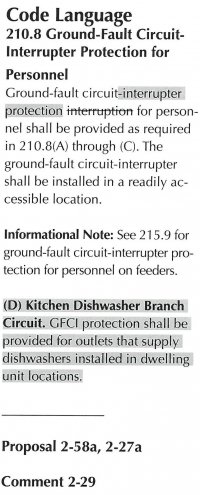NEC 422.16 (2)
(4) The receptacle shall be located in the space occupied by the appliance OR adjacent thereto.
(5) The receptacle shall be accessible.
Q. Dishwasher outlet is behind dishwasher with cord and plug, is this permitted? I don't think the outlet would be accessible meeting (5).
But (4) has me comfussed, would this be for a roll-out dishwasher?
(4) The receptacle shall be located in the space occupied by the appliance OR adjacent thereto.
(5) The receptacle shall be accessible.
Q. Dishwasher outlet is behind dishwasher with cord and plug, is this permitted? I don't think the outlet would be accessible meeting (5).
But (4) has me comfussed, would this be for a roll-out dishwasher?
Last edited by a moderator:



